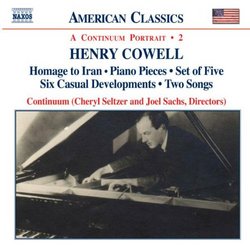| All Artists: Raymond Murcell, Henry Cowell, Continuum, Cheryl Seltzer, Joel Sachs Title: Henry Cowell: Instrumental, Chamber and Vocal Music, Vol. 2 Members Wishing: 0 Total Copies: 0 Label: Naxos American Release Date: 2/22/2005 Genres: Pop, Classical Styles: Vocal Pop, Chamber Music, Forms & Genres, Short Forms, Historical Periods, Classical (c.1770-1830), Modern, 20th, & 21st Century, Instruments, Keyboard, Reeds & Winds, Strings Number of Discs: 1 SwapaCD Credits: 1 UPC: 636943919323 |
Search - Raymond Murcell, Henry Cowell, Continuum :: Henry Cowell: Instrumental, Chamber and Vocal Music, Vol. 2
 | Raymond Murcell, Henry Cowell, Continuum Henry Cowell: Instrumental, Chamber and Vocal Music, Vol. 2 Genres: Pop, Classical
|
Larger Image |
CD Details |
CD ReviewsA good overview of Cowell's various compositional styles Discophage | France | 09/03/2007 (4 out of 5 stars) "This is the reissue of volume 2 of the Cowell collection played by the New York ensemble Continuum. The piano pieces, two songs and "Set of Five" were recorded in 1984 (only in the latter can the earlier date of recording be sensed, through a less vivid sonic pickup) and released on LP by Musical Heritage Society. "Homage to Iran" and "Six Casual Developments" were recorded in 1992 for the first CD release.
Volume 1 (Henry Cowell: Instrumental, Chamber and Vocal Music, Vol. 1) was a bit disappointing, as it did not present the most interesting pieces of the composer. This one is much more appealing. Of all the pieces featured here the "Six Casual Developments" for clarinet and piano (1933) is the most traditional and less remarkable. It is a suite of neo-classical contour with some jazzy twists - the composer's "only attempt at jazz-influenced style" according to the liner notes. Still it would nicely fit in a concert or disc program with similar works by Poulenc and Milhaud and Stravinsky's Three Pieces for Solo Clarinet. The two songs from 1936 after poems of Catherine Riegger (composer Wallingford Riegger's daughter) are muscially more interesting than the Three Anti-Modernist Songs featured on volume 1. The music is tonal and the vocal line mostly Romantic, but the piano accompaniment uses the clusters so typical of Cowell, strongly hammered or hautingly hushed, and, as the notes aptly put it, bring "the poetry to life in a manner that is simultaneously traditional and modern". The atmosphere is close to Ives more "mystical" songs. "Homage to Iran" (1957) is a fascinating piece of Western-Mid-Eastern crossover. Joel Sachs has had the brilliant idea to substitute a Persian zarb (Iranian drum) for the piano in the 1st and 3rd pieces, in order to realize Cowell's original intent. The result is a fascinating blend of Western violin technique and tone production and Mid-Eastern melismatic sound-world, bringing to mind Enescu's 3rd Violin and Piano Sonata "Dans le caractère populaire roumain" (in the Rumanian Folk Character): it would make a great companion piece. Not entirely surprisingly the music also has a marked Jewish flavor evocative of Bloch's Baal Shem ("typical" Gipsy and Jewish music share a common, mid-eastern origin I believe, and moreover there was a sizeable Jewish community in Iran in those years, if I am not mistaken). "Set of Five" for violin, percussion and piano (1952) is another percursor of today's World music and cross-over styles, mixing the baroque-inspired violin and piano suite with a wide array of exotic percussion instruments, giving it color as well as rhythmic bite and dynamism. One hears graphically were Cage took his inspiration. The choice of piano pieces exemplifies Cowell at his most inventive and radical: tone clusters and directly harped strings. "Piece for piano" is an extraordinary study in unusual modes of sound production, with violently hammered clusters of overwehlming power. "Vestiges" is an Ivesian study in polyrythms on a theme reminiscent of the Dies Irae. "What's This" is the first (out of five) encore to Cowell's "Dynamic Motion" and a short study in kinetic energy. "The Banshee" is arguably Cowell's masterpiece, a composition that George Crumb could have written, played entirely on the piano's open strings and putting to full use all the techniques invented by the composer (strings swept or plucked with finger flesh or nail) at the service of a terrifying evocation of the "fairy woman who comes at the time of death to take the soul back into the Inner World" (to quote the composer's own description). The two other pieces, "Euphoria" (maybe "Euphonia", Cowell's handwriting is apparently difficult to decipher here) - another Ivesian study in polyrythms, in dreamy mood this time - and "Elegie" are unpublished and this is the only recording of them I am aware of. "Elegie", like much of Cage's Studies for prepared piano, wouldn't amount to much - a simple left hand melody with arpeggiated harmonic chords - if it wasn't for Cowell's unutsual modes of tone production (strings simultaneously plucked and hammered, harped, hammered while dampened with the finger) employed to great coloristic effect. Cheryl Seltzer plays with a dynamism and muscularity which yields contrasted results: much more adrenalin than Stephen Schleiermacher (but still greater clarity of texture) in "Piece for piano" (see American Ultramodernists 1920-1950), Ivesian cacophony in "Vestiges" rather than atmosphere as Alan Feinberg in his "American Innovator" collection (The American Innovator), at a markedly slower tempo, better respect of the score - notes, rhythms and dynamics - than the composer himself (Piano Music) in "What's This" and hence greater kinetic energy. But she is no match to the mesmerizing evocative power of Cowell in "The Banshee": with her you hear the eerie sounds metallic strings being swept with flesh or nail - with him you hear not an instrument but the terrifying moans of the Banshee. Still, this disc offers a good overview of Cowell's various compositional styles. But for Cowell's mesmerizing piano music - arguably his most essential contribution to the history of music - the composer's own recording is the good place to start. " |

 Track Listings (23) - Disc #1
Track Listings (23) - Disc #1